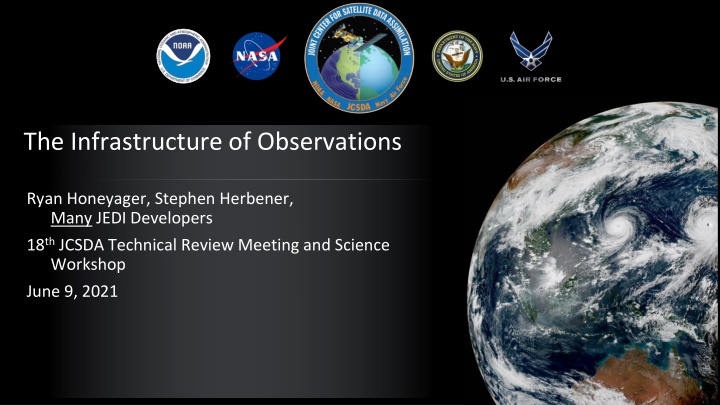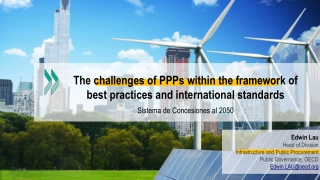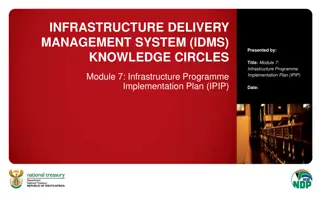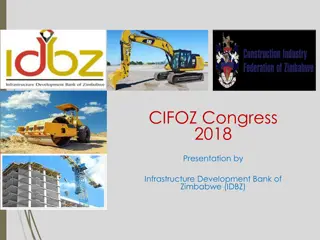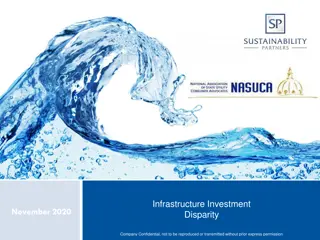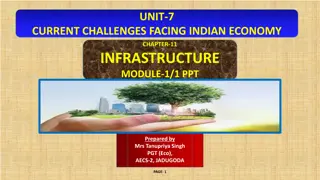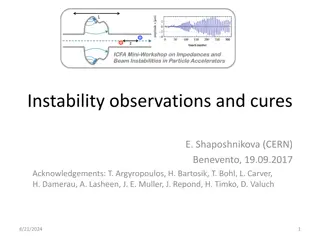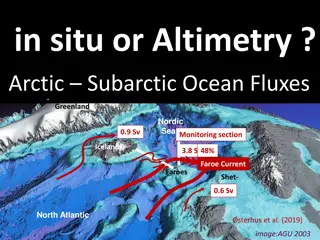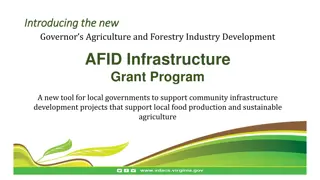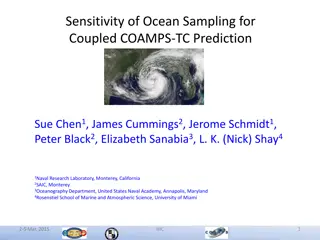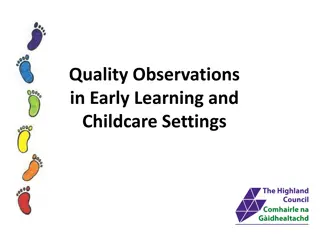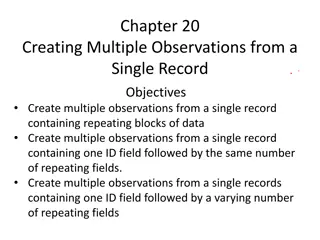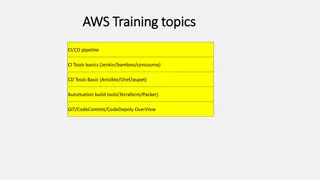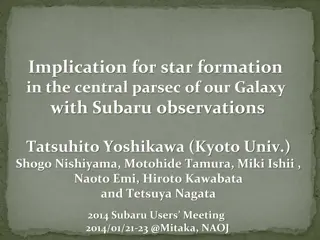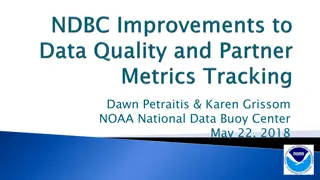The Infrastructure of Observations
The infrastructure of observations plays a crucial role in data assimilation and integration processes. This includes converters, data flow operations, bias correction, observation data spaces, and more. Efforts are made to ensure easy access, separation of concerns, uniform interface, and flexible design for efficient handling of observation data.
Download Presentation

Please find below an Image/Link to download the presentation.
The content on the website is provided AS IS for your information and personal use only. It may not be sold, licensed, or shared on other websites without obtaining consent from the author.If you encounter any issues during the download, it is possible that the publisher has removed the file from their server.
You are allowed to download the files provided on this website for personal or commercial use, subject to the condition that they are used lawfully. All files are the property of their respective owners.
The content on the website is provided AS IS for your information and personal use only. It may not be sold, licensed, or shared on other websites without obtaining consent from the author.
E N D
Presentation Transcript
The Infrastructure of Observations Ryan Honeyager, Stephen Herbener, Many JEDI Developers 18thJCSDA Technical Review Meeting and Science Workshop June 9, 2021
JEDIs Observation Data Flow Converters Joint Effort for Data assimilation and Integration BUFR (WMO and NCEP) R2D2 ODB GSI ncdiags IODA UFO OOPS Marine Models Diagnostics METARs June 9, 2021 R Honeyager, JCSDA 2
Different Classes, Similar Tasks Use Case Description Language Data ingest Creation of Observation Spaces Python, Fortran Bias Correction Read and update data C++ GeoVaLs Perform interpolation to align observations and models Fortran / (C++) Operators Read and update data C++, Fortran ObsDiagnostics Store ancillary data produced by an operator Fortran / (C++) Filters Assign QC flags and update observation error estimates C++, Fortran ObsFunctions Calculate derived quantities from data in the ObsSpace, HofX, diagnostics, or GeoVaLs Condense data and generate plots C++ Diagnostics Python R2D2 Track metadata associated with on-disk ObsSpaces Python June 9, 2021 R Honeyager, JCSDA 3
Observations Need Infrastructure Data contract: a formal agreement between a service (IODA) and users that abstractly describes both the data to be exchanged and the API for accessing data. Users want: Easy and efficient access to observation data. To isolate science from data storage technicalities (separation of concerns). We aim for a: Uniform programming interface, Uniform data layout, and Flexible, object-oriented, and generic design. June 9, 2021 R Honeyager, JCSDA 4
Steve Herbener Tuesday at 9:05 IODA v2 Release (this week) After Release (Summer) Planned / Potential IODA 2: Abstract Interfaces Extension of JEDI s abstract interfaces and separation of concerns to IODA. HDF5 ObsStore BUFR ODC YAML NetCDF IODA: Groups, Variables, Dimensions, Attributes, Type System ObsSpace Bias Diagnostics Other Containers Converters User-facing classes Cross-language bindings (C++, C, Python) Multidimensional data support June 9, 2021 R Honeyager, JCSDA 5
IODA 2: Client-Side Data Layout IODA 1.0 Observation Files IODA 2.0 Observation Files ioda-upgrade.x old_file new_file June 9, 2021 R Honeyager, JCSDA 6
Greg Thompson Today at 10:30 IODA 2: Variable Naming JCSDA OBS project is working on defining consistent IODA layout and variable naming conventions. Summer code sprint apply conventions to converters and UFO Name brightnessTemperature radiance instrumentIdentifier sensorChannelNumber Units Kelvin W m-1sr-1 None None Data Type 32-bit float 32-bit float Variable-length string Unsigned 32-bit integer June 9, 2021 R Honeyager, JCSDA 7
IODA 2: Data Storage Implementations Implementation Data source Current Memory Memory File Potential (network-optimized) S3 bucket / Hadoop Read only Database / file File HTTP / S3 Zarr I/O support ObsStore HDF5 HDF5 Read / write Read / write Read / write HDF5 ODC NetCDF NetCDF NetCDF Read / write Read / write Read only Read / write June 9, 2021 8 R Honeyager, JCSDA
Hui Shao Friday at 8:05 Observations and Filters Abstract observation filters are run before and after an observation operator. Filters are written once and used with many observation types. They are configurable via YAML. Observation filters have access to: Observation values and metadata - Model values at observations locations (GeoVaLs) - Simulated observation value and diagnostics (for post-filter) - Their own private data - June 9, 2021 R Honeyager, JCSDA 9
A process of observation Screening, Error Inflation, and *Error Bound Tightening from their original values QC Example for IASI Surface Jacobian Check Wavenumber Cloud Detection Obs BT Check Check tzr_qc=0 No Cloud Detected Near SST Check Surface Sensitivity Check Topography Check tzr_qc=1 *Model Top Transmittance Check Gross Check Source: Emily Liu, NOAA/EMC *Latitude Check Minimization June 9, 2021 10 R Honeyager, JCSDA
A process of observation Screening, Error Inflation, and *Error Bound Tightening from their original values QC Example for IASI Surface Jacobian Check Wavenumber Cloud Detection Obs BT Check Check tzr_qc=0 No Cloud Detected Near SST Check Surface Sensitivity Check Topography Check tzr_qc=1 *Model Top Transmittance Check Gross Check Source: Emily Liu, NOAA/EMC *Latitude Check Minimization June 9, 2021 11 R Honeyager, JCSDA
A process of observation Screening, Error Inflation, and *Error Bound Tightening from their original values QC Example for IASI Surface Jacobian Check Wavenumber Cloud Detection Obs BT Check Check tzr_qc=0 No Cloud Detected Near SST Check Surface Sensitivity Check Topography Check tzr_qc=1 *Model Top Transmittance Check Gross Check Source: Emily Liu, NOAA/EMC *Latitude Check Minimization June 9, 2021 12 R Honeyager, JCSDA
A process of observation Screening, Error Inflation, and *Error Bound Tightening from their original values QC Example for IASI Surface Jacobian Check Wavenumber Cloud Detection Obs BT Check Check tzr_qc=0 No Cloud Detected Near SST Check Surface Sensitivity Check Topography Check tzr_qc=1 *Model Top Transmittance Check Gross Check Source: Emily Liu, NOAA/EMC *Latitude Check Minimization June 9, 2021 13 R Honeyager, JCSDA
Future QC Capabilities Permanent storage of derived data Derived data: any data not provided directly by ioda converters / quantities calculated in UFO. We should store ObsFunction results. Ex: conversion of winds from speed and direction to u and v. Expanded QC data storage QC steps should be able to return more than just a pass/fail flag. 1. 2. Both 1 and 2 depend on further rollout of the IODA 2 changes to UFO. June 9, 2021 R Honeyager, JCSDA 14
Final Remarks JEDI s observation infrastructure is maturing and is highly adaptable. IODA 2.0 release Next steps: Update converters and diagnostic codes to use IODA 2 s new Python interface Extend UFO filtering capabilities Continuous, agile performance optimization June 9, 2021 R Honeyager, JCSDA 15
